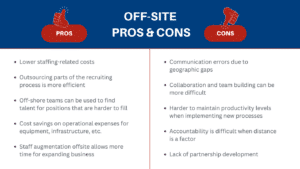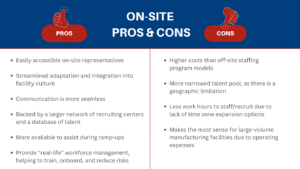Choosing the right staffing model for your manufacturing facility can be a challenging task. It is important to consider your goals and carefully weigh the pros and cons of off-shore and on-site staffing models. Doherty Staffing Solutions understands the intricacies of both models and can provide the expertise you need to help make the best workforce management decision.
In the fifth installment of our on-site workforce management series, we will explore the differences between off-shore/off-site and on-site/vendor-on-premise staffing models to determine which is the best fit for you and your manufacturing facility’s operational goals.
What are Off-site Staffing Models?
Off-site or off-shore staffing models refer to an employment strategy where recruiters source and manage workers who are from different locations or countries than the actual facility’s location. These groups of workers are often referred to as RPO Programs (Recruitment Process Outsourcing). This model allows companies to tap into a geographically wider talent pool and access specialized skills that may not be available locally.
These models offer flexibility in terms of scaling up or down the workforce based on business needs. Additionally, off-site staffing models can provide significant cost savings as companies can leverage lower labor costs in certain regions. They can also help businesses operate around the clock by utilizing staffing teams in different time zones.
However, off-site staffing models also come with challenges. Communication and collaboration can be more challenging when team members are not physically present. Companies need to establish clear communication channels and processes to ensure effective collaboration in off-site staffing models.
What are On-site Staffing Models?
On-site or vendor-on-premise staffing models involve hiring and managing contingent workers at your manufacturing facility’s physical location, with a team of staffing and recruiting specialists at your side in your facility. This model allows for closer collaboration and immediate access to resources, making it easier to align with your company’s culture and production goals.
In on-site staffing models, staffing representatives are an extension of the manufacturing facility’s internal HR team. This close proximity fosters real-time communication, facilitates knowledge sharing, and promotes stronger relationships between all team members.
On-site staffing models are beneficial for projects that require close coordination and they provide a higher level of control and supervision compared to off-site models.
However, on-site staffing models can be more expensive, especially when additional costs like equipment and infrastructure are considered. They may also limit access to a diverse talent pool due to geographic restrictions.
Overall, on-site staffing models offer advantages in terms of collaboration and cultural alignment, while off-site staffing models provide flexibility and access to a geographically wider talent pool.
Comparing Pros and Cons
When comparing off-site/off-shore and on-site staffing models, it’s important to consider the pros and cons of each approach. Here is a side-by-side comparison of the pros and cons of each staffing model that you can reference to make the best decision for your manufacturing facility.
Ultimately, the choice between off-shore and on-site staffing models depends on the specific needs and goals of your manufacturing facility.
Additional Factors to Consider
When deciding between off-site/off-shore and on-site staffing models, consider the following factors:
- Nature of the work: Some tasks may require close collaboration and immediate access to resources, making on-site staffing more suitable. For projects that can be effectively managed remotely, off-site/off-shore staffing can be a viable option.
- Cost considerations: Evaluate your employment budget and investment variances of each staffing model. Off-site/off-shore staffing models may offer lower staffing-related costs, but additional expenses like communication tools and travel may need to be considered.
- Skills and expertise required: Assess whether the project requires specific skills or expertise that are available locally or can be accessed through off-site/off-shore staffing. Consider the availability of workers and the impact on project timelines.
- Communication and collaboration: Evaluate the importance of real-time communication and collaboration for the project. Determine whether the benefits of in-person interaction outweigh the challenges of off-site coordination.
- Cultural fit: Consider the cultural alignment between the company and the off-site/off-shore staffing team. Differences in work culture and time zones may impact collaboration and productivity.
By considering these factors, manufacturing facilities can make an informed decision on the most suitable staffing model for their specific needs.
Making the Best Choice
In closing, choosing between off-site/off-shore and on-site staffing models requires a thorough evaluation of your manufacturing facility requirements, project scope, and available resources. It’s essential to carefully analyze the pros and cons of each model and consider the specific factors mentioned above.
Doherty Staffing Solutions is an expert when it comes to implementing scalable, customizable workforce solutions. If you are seeking a strategic on-site workforce management partner, get connected with us today!



